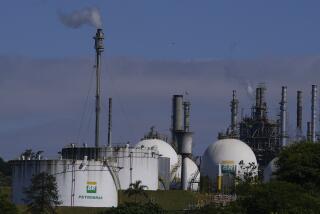EPA Appeals to 600 Firms to Curtail Toxic Pollution : Environment: Voluntary compliance is vital, agency chief says. He seeks a 50% reduction in emissions from 17 chemicals by 1995.
- Share via
WASHINGTON — Saying that the Bush Administration wants to avoid “an adversarial relationship” with business, the head of the Environmental Protection Agency on Thursday urged 600 industrial firms to voluntarily reduce pollution from 17 toxic chemicals.
“We want to demonstrate what can be achieved through a cooperative effort,” said EPA Administrator William K. Reilly, who announced that he is writing to the chief executives of the nation’s largest polluters in hopes of achieving a one-third reduction in pollution from these chemicals by 1992 and a 50% cut by 1995.
“These are aggregate national goals, which may not be achievable or appropriate for every company or every plant,” Reilly said in his letter.
Reilly said at a press conference that he believes many industrial leaders “are ready to step up to the plate” as good corporate citizens to help reduce troublesome pollutants. “If we succeed, the initiative could set the pace for a new, cooperative way of addressing the nation’s environmental goals,” he said.
Reilly said that he was pleased by positive results from a smaller effort last year in which he personally contacted the officers of about 50 large industrial plants, mainly in the chemical and paper-processing industries.
Although he did not offer details of what was accomplished, he said that business executives found there are positive advantages in reducing pollution.
“Companies can save on waste management, reduce the use of raw materials and minimize liability,” Reilly said. “And, moreover, by taking this approach, companies can help relieve themselves of regulatory burdens.”
Thirty-five California companies, including most of the large aerospace firms in Southern California, are among the 600 to whom Reilly appealed. But the majority of the companies are located in the northeastern United States and the Great Lakes region. Most are engaged in the petroleum, chemical, rubber and equipment-manufacturing businesses.
Reilly described the firms on his list as “the largest contributors to a universe of 1.4 billion pounds of toxic wastes at over 11,000 facilities.”
But being a source of such pollution “does not indicate that a company is mismanaged or out of compliance with pollution control regulations,” he said, noting that environmental laws provide for a gradual phase-out of certain chemical emissions.
The 1990 Clean Air Act requires the EPA to begin this year to issue standards for 189 pollutants, including the 17 targeted in Reilly’s letter. Reilly said that he hopes the managers of large plants will “help reduce toxic pollution ahead of schedule . . . (and) act now rather than wait for statutory deadlines.”
Red Cavaney, president of the American Paper Institute, said that the pulp and paper industry supports the EPA’s move toward voluntary compliance, saying that “cooperative government-industry efforts” represent “sound national policy.”
Ann Maest, spokesman for the Environmental Defense Fund, called Reilly’s initiative “a good first step that goes beyond the rhetoric we’ve been hearing.” Maest said that the fund and other environmental groups will “seek to have some input in the agreements that EPA works out with large corporations.”
The chemicals involved in the voluntary outreach are benzene, cadmium and its compounds, carbon tetrachloride, chloroform, chromium and its compounds, cyanides, dichloromethane, lead and its compounds, mercury and its compounds, methyl ethyl ketone, methyl isobutyl ketone, nickel and its compounds, tetrachloroethylene, toluene, trichloromethane, trichlorethylene and xylenes.
More to Read
Sign up for Essential California
The most important California stories and recommendations in your inbox every morning.
You may occasionally receive promotional content from the Los Angeles Times.













